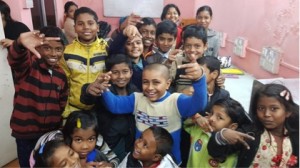Notions of gender and gender stereotypes, more often than not, build up in people in their early processes of socialization as children. It can be as trivial as a pink coloured comb belonging to a girl and a black motorcycle belonging to a boy. In our small attempt to create a more gender-neutral classroom space, Priyanka and I conducted a small activity in our class one evening—which was quite different from the usual story-telling session.
We took a chart paper and made two columns, one with the heading Uncle and the other Aunty. The space in the middle was reserved for ‘both’. Paroma had brought pictures of a few day to day objects like a stove, cycle, bike, mirror, comb, hair pin, car and so on. We placed all of these on the ground and asked the children to pick an object and place them under whichever heading that they thought would be appropriate. As expected, objects like the stove, comb and hairpin were under Aunty and bike, cycle, car were under Uncle. After placing the pictures, we asked them the reasons behind their choice. This led us to a long discussion where we explained to them how every object was gender neutral no matter what colour it was or how it looked. We showed them pictures of women riding motorcycles, men cooking and wearing pink coloured clothes for a clearer perspective on gender neutrality. The children also spoke about their experiences with respect to this. Eleven years old Rani was teased by her friends in school, who called her names because she had cut her hair completely short.
We also planned to tell them stories like Kabir the Hopscotchher in the following class which was about a little boy named Kabir who did not want to play football with his male friends but instead found playing hopscotch with his female friends as a more fun game. The story in a simple way, spoke about how the boys and girls always had separate games (like football and Hopscotch) and how this division should be neutral and according to ones choice of fun and not gender.
We might not have been able to completely convince them but the fact that even some of them were thinking and questioning the gendering of everyday small objects around them in the class itself showed us how this socialization is not rigid and can in fact, be changed in each one of us with a little bit effort.
– Apoorva Sekhar
Volunteer, Share Stories Open Minds

